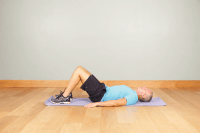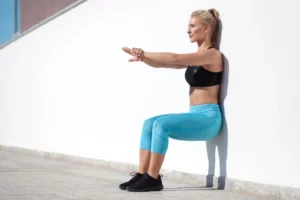Diastasis recti, a condition where the abdominal muscles separate, is a common issue, especially among postpartum individuals. While it’s a natural response to pregnancy, it can lead to various problems if left untreated. Fortunately, there are effective therapies available to help restore core strength and function. In this blog, we’ll explore diastasis recti, its causes, and therapies that can make a significant difference in recovery.
Contents
Understanding The Causes Of Diastasis Recti
Diastasis Recti, often referred to as abdominal separation, is a common condition characterized by the separation of the rectus abdominis muscles, which are the large, flat muscles that run vertically down the front of the abdomen. While pregnancy is a well-known factor in the development of diastasis recti, it can also occur due to various other causes and factors:
- Pregnancy: The physical changes that occur during pregnancy are a leading cause of diastasis recti. As the uterus expands to accommodate the growing fetus, it places significant stress on the abdominal muscles and the connective tissue between them, leading to separation.
- Incorrect Abdominal Exercises: Performing certain abdominal exercises incorrectly or engaging in exercises that strain the abdominal muscles can contribute to diastasis recti. Traditional crunches and sit-ups, for example, may worsen the condition if not executed with proper form.
- Excessive Abdominal Pressure: Activities that involve repetitive or chronic increases in intra-abdominal pressure, such as heavy lifting, constant straining, or even chronic coughing, can lead to the development or worsening of diastasis recti.
- Genetic Predisposition: Some individuals may have a genetic predisposition to weakened connective tissue in the abdominal area, making them more susceptible to diastasis recti.
- Multiple Pregnancies: Women who have experienced multiple pregnancies are at a higher risk of developing or worsening diastasis recti due to repeated stretching and stress on the abdominal muscles.
- Age: As individuals age, the elasticity and strength of the abdominal muscles and connective tissue can naturally decrease, increasing the risk of diastasis recti.
- Previous Surgeries: Prior abdominal surgeries, such as cesarean sections or abdominal hernia repairs, can weaken the abdominal muscles and contribute to the development of diastasis recti.
Types Of Therapies For Diastasis Recti
There are several effective therapies available to help with diastasis recti and restore abdominal strength. Here’s a closer look at these therapies:
- Physical Therapy: Physical therapists with expertise in diastasis recti can create personalized exercise programs. These programs focus on strengthening the core muscles, gradually closing the gap between the abdominal muscles. Physical therapy sessions involve guidance on performing exercises correctly and monitoring progress.
- Corrective Exercises: Specific exercises play a crucial role in diastasis recti recovery. These exercises target the affected muscles and include movements like pelvic tilts, abdominal bracing, and transverse abdominal contractions. They help activate the deep core muscles and promote healing.
- Manual Therapy: Techniques such as myofascial release and deep tissue massage can be incorporated into a diastasis recti treatment plan. These therapies aim to release muscle tension and improve muscle function, assisting in the healing process.
- Posture Correction: Maintaining proper posture is essential for preventing the worsening of diastasis recti. Therapists often provide guidance on posture improvement, teaching individuals how to support their abdominal muscles during daily activities.
- Breathing Techniques: Diaphragmatic breathing, also known as deep belly breathing, is a fundamental skill for diastasis recti recovery. This technique helps activate the transverse abdominis muscles, reduce intra-abdominal pressure, and support core stability.
- Supportive Garments: Abdominal binders or support belts can provide additional support during the healing process. These garments help reduce strain on the abdominal muscles and promote proper alignment.
- Nutrition and Hydration: Adequate nutrition and hydration are vital for overall recovery. A well-balanced diet rich in essential nutrients supports healing, and staying hydrated keeps muscles and tissues adequately lubricated.
- Lifestyle Modifications: Making lifestyle adjustments is crucial for diastasis recti management. This includes avoiding activities that strain the abdominal muscles, lifting objects with proper form, and maintaining a healthy weight to reduce pressure on the abdominal area.
Medical Interventions For Diastasis Recti 
While diastasis recti, often responds well to conservative therapies and exercises, some cases may require medical treatments, especially if the condition is severe or accompanied by complications. Here are some medical treatments for diastasis recti:
- Surgical Intervention: In severe cases of diastasis recti that do not respond to conservative treatments, surgical intervention may be considered. This procedure, known as abdominoplasty or a tummy tuck, involves the surgical repair of the separated abdominal muscles and the removal of excess skin. It’s important to note that surgery is typically reserved for cases where the diastasis is causing significant functional impairments or aesthetic concerns.
- Minimally Invasive Procedures: Some less invasive procedures, such as endoscopic-assisted diastasis recti repair, may be an option for individuals with diastasis recti. These procedures use small incisions and specialized instruments to repair the separated muscles without the need for extensive surgery.
- Mesh Placement: In certain cases, surgeons may use surgical mesh to reinforce the repaired abdominal muscles. This provides additional support and stability to the weakened area.
- Electrical Stimulation: Electrical stimulation therapy, may be used as an adjunct to rehabilitation. It involves the use of electrical impulses to contract and strengthen the abdominal muscles. This therapy is typically used under the guidance of a physical therapist.
- Botox Injections: In some cases, Botox injections may be considered as a temporary measure to reduce muscle activity and tension in the abdominal area. This can be used in conjunction with other treatments to facilitate healing.
- Physical Therapy Referral: While not a medical treatment, a referral to a physical therapist with expertise in diastasis recti is a crucial step. Physical therapists can provide guidance on exercises and therapies tailored to an individual’s specific needs.
Exercises For Diastasis Recti Relief
Diastasis recti, a separation of the abdominal muscles, often responds well to targeted exercises that focus on strengthening the core. These exercises help close the gap between the abdominal muscles and provide relief. Here are some effective exercises for diastasis recti relief:
Transverse Abdominis Activation
This exercise targets the deepest layer of your abdominal muscles, the transverse abdominis.
- Begin by lying on your back with your knees bent and feet flat on the floor.
- Place your hands on your lower abdomen, just above your hip bones.
- Inhale deeply, expanding your belly.
- Exhale slowly, drawing your belly button toward your spine.
- Hold this position for a few seconds, then relax.
- Repeat this exercise for several breaths.
Pelvic Tilts
Pelvic tilts engage the lower abdominal muscles and can help improve core stability.
- Lie on your back with your knees bent and feet flat on the floor.
- Tighten your abdominal muscles and flatten your lower back against the floor.
- Hold for a few seconds, then release.
- Repeat this exercise for 10-15 repetitions.
Leg Slides
Leg slides are a gentle way to engage the abdominal muscles without putting too much strain on them.
- Lie on your back with your knees bent and feet flat on the floor.
- Slowly slide one foot along the floor, straightening your leg.
- Keep your abdominal muscles engaged while you slide your leg.
- Return your leg to the starting position.
- Alternate legs and repeat for several repetitions.
Wall Sits
Wall sits engage the entire core, including the transverse abdominis and obliques.
- Stand with your back against a wall and your feet hip-width apart.
- Slide down the wall until your knees are bent at a 90-degree angle.
- Hold this position, engaging your core muscles.
- Start with holding for 10-15 seconds and gradually increase the duration.
Bridge Pose
Bridge pose strengthens the glutes, lower back, and abdominal muscles.
- Lie on your back with knees bent, feet flat on the floor, and arms by your sides.
- Press through your heels to lift your hips off the floor, creating a straight line from your shoulders to your knees.
- Squeeze your glutes and engage your core.
- Hold for a few seconds, then lower your hips back down.
- Repeat for several repetitions.
Dead Bug Exercise
The Dead Bug exercise targets the transverse abdominis and helps stabilize the core.
- Lie on your back with your arms extended toward the ceiling.
- Lift your legs, so your knees are directly above your hips, and your shins are parallel to the floor.
- Lower one arm and the opposite leg toward the floor while keeping your lower back pressed into the floor.
- Return to the starting position and switch sides.
- Repeat for several repetitions on each side.
Plank with Knee Taps
Planks are excellent for overall core strengthening, and adding knee taps increases the challenge.
- Begin in a plank position with your forearms on the floor and your body in a straight line from head to heels.
- While keeping your core engaged, slowly tap one or both knees to the ground and then the other.
- Alternate tapping knees for 10-15 repetitions on each side.
Tips For Preventing Recurrence Of Diastasis Recti
Here are some tips to help you maintain a healthy core and reduce the risk of diastasis recti recurrence:
- Continue Core-Strengthening Exercises: Once you’ve improved your diastasis recti, don’t stop doing core-strengthening exercises. Consistent exercise helps maintain the strength of your abdominal muscles. Continue to incorporate exercises like transverse abdominis activation, pelvic tilts, and leg slides into your routine.
- Progress Gradually: If you’re following a structured exercise program to recover from diastasis recti, make sure you progress gradually. Increasing the intensity and difficulty of exercises too quickly can strain your abdominal muscles. Follow your physical therapist’s or healthcare provider’s recommendations for progression.
- Use Proper Lifting Techniques: When lifting heavy objects or children, use your legs and not your core muscles to do the work. Bend your knees, keep the object close to your body, and engage your leg muscles to lift. Avoid twisting your torso while carrying weight.
- Manage Weight Gain During Pregnancy: If you become pregnant again, aim for healthy weight gain and follow your healthcare provider’s guidance. Excessive weight gain during pregnancy can put extra strain on the abdominal muscles.
- Consult with a Specialist: If you’re planning to have more children or have specific concerns about diastasis recti recurrence, consult with a physical therapist or healthcare specialist who specializes in women’s health and abdominal health. They can provide personalized guidance and exercises tailored to your needs.
- Be Mindful of Abdominal Pressure: Avoid exercises or activities that excessively increase intra-abdominal pressure, such as heavy lifting, intense coughing, or straining during bowel movements. These actions can strain the abdominal muscles and potentially contribute to diastasis recti recurrence.
Conclusion
In conclusion, diastasis recti, while common, is a condition that can be effectively managed and treated with the right therapies and exercises. Whether you’re a new mother looking to regain core strength post-pregnancy or anyone seeking relief from abdominal separation, the key lies in a comprehensive approach that includes targeted exercises, physical therapy, and lifestyle modifications. By understanding the causes, seeking appropriate therapies, and following a tailored exercise plan, you can significantly improve diastasis recti and enhance your core strength.
Physical Therapy helps patients recover from pain. If you’re experiencing Back, Shoulder, Knee, Neck, Elbow, Hip, or Arthritis pain, a physical therapist at PhysioMantra can help: Book an online physical therapy session.











